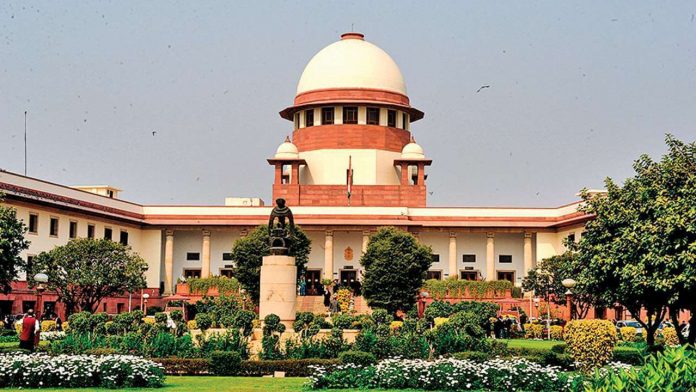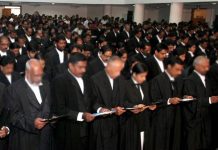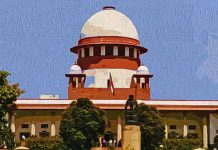This article is written by Sanjana Jain, a student of Guru Gobind Singh Indraprastha University, Delhi.
Table of Contents
Introduction
For lawyers practice in Bar is an opportunity as well as a challenge. But practicing in the Supreme Court i.e the highest court of India is a dream for most. But that itself is a restraint. As just anybody can not go and practice in the apex court of law, certain qualifications are needed. One has to be an Advocate on Record. According to order IV of the Supreme court Rules, 2013 an Advocate on Record is an advocate who is entitled to act as well as plead for a party in the Supreme Court of India. Advocates of all categories can appear before the Supreme Court, but the ones who clear the Advocate on Record exam are only eligible to appear as well as plead for a party in the Supreme Court.
In 2014, the Bar Council of India with the New Certificate of Practice and Renewal Rules, 2014 has stated that “5 years experience is a must to be a Supreme Court lawyer”. An advocate must practice for at least 2 years in the trial court and for 3 years in a High Court in India. The reason for this new rule is that there is an urgent need for putting some conditions for practicing law in different courts in order to give due weightage and credit to experience. Such that before advocates practice in the higher court they are exposed to real court experiences. This will help them in gaining new skills and in integrating the whole judicial system from the perspective of the bar.
How to build a practice at SC: The complementary elements
For young lawyers who wish to practice in the Supreme Court of India, the path to the same is not easy at all. They have to be a practicing Advocate on Record for a year. The Certificate of Practise and Renewal Rules, 2014 lays down the conditions after fulfillment of which an advocate can be enrolled in the Supreme Court of India and practice thereafter. The conditions provided are mentioned below:
- The requirement for young lawyers who want to be registered at the Supreme Court is a post qualification experience of 5 years which must include 2 years experience in the trial court and 3 years of experience in the High Court. Only after this, the advocate is allowed to appear in training conducted by the Advocate on Record.
- The Advocate on Record examination which is conducted by the Board examiners under the governance and regulation of the Supreme Court must be taken by the advocate with the 5-year experience as provided above. Once the examination is cleared by the advocate, they are supposed to hold a registered office which must be accompanied by a registered clerk. The office must be located within 10 miles of the Supreme Court’s location.
The detailed structure of the exam
The main purpose of the Advocate on Record exam is to ensure that those appearing in the Apex Court are highly equipped with the necessary knowledge and experience. Advocate on Record is not only a prestigious title, it is a title that comes with a huge responsibility. As an advocate on record one is expected to be a higher officer of the court in the truest sense. The system of Advocate on record has also been challenged on the ground that it creates class among lawyers and restricts other lawyers from appearing before the Supreme Court, but the said challenge was dismissed. Following are the details of the AOR examination:
- The time period of the exam is 3 hours.
- The structure of the exam is that the examination has been divided into 4 different papers that are to be conducted on 4 different days.
- Paper is of 100 marks which consist of 27 questions divided into four papers.
- The candidate must secure 50% marks in each paper along with 60% of aggregate marks to qualify in the examination.
- The option for reappearing specifically exists for one paper only for those candidates who have secured 60% marks in aggregate but have failed to secure 50% marks in one paper. Examination fees need to be paid accordingly.
- Similarly, if a candidate fails to secure 60% marks in aggregate but has obtained 50% marks in papers then the option of reappearing is available for any one of the four papers of the candidate’s choice. The examination fee needs to be paid accordingly.
- The candidates are given five chances to appear in the examination.
The pattern of the examination
The Board of Examiners of the Supreme Court conducts the AOR exam. These examiners are appointed by the committee of 3 judges who are nominated by the Chief Justice of India for this purpose.
As it is evident from the past years’ question papers the pattern of the examination varies from time to time. The examination may consist of essay-type questions for which lengthy answers are required. The pattern of the AOR exam is not like the pattern followed in colleges such as the Faculty of Law, Delhi University, or Government Law Colleges in Bombay. Multiple-choice questions may also be included in the paper. The paper may also give a choice between two questions or a choice between ten out of twenty questions. As there is no fixed pattern for the examination the candidate shall be mentally prepared for either eventuality.
Syllabus
The syllabus of the AOR exam is divided into 4 papers that are:
1. Practice and procedure of Supreme Court
This paper consist of :
- The Indian Constitution, 1950
- The Civil Procedure Code, 1908
- The Limitation Act, 1963
- Court Fees Act, 1870
2. Drafting
Drafting is one of the most important skills that every practicing advocate must be aware of. This consist of:
- Special Leave Petition
- Review Petition
- Transfer petition
- The petition of Appeal
- Application of revocation of special leave and other necessities.
3. Advocate and professional ethics
This paper makes sure that the advocate must possess the knowledge of ethics involved in advocacy. This paper consists of:
- The Advocates Act
- Cases concerning contempt of court
- Supreme court Rules
- Bar Council of India Rules
4. Leading cases
It is necessary for an individual to be aware of landmark judgements and cases to be enrolled as a practicing advocate in any court, in order to have knowledge of the implications of statutes in a realistic world. This paper consists of those cases which led to the change in any statute by means of amending, scrapping, or adding provisions to the same.
Present scenario
Recently, the Bar Council of India has stated that qualifying the All India Bar Examination will not be sufficient for any young lawyer to practice in any High Court or Supreme Court directly after graduating with an LLB degree. For further practice in Higher Courts along with the exam qualification, it is essential to have experience of practicing in the lower courts. Presently, every advocate is allowed to appear in the Supreme Court of India, but only the Advocate on record is vested with the authority to practice and argue on behalf of his/her client in the Supreme Court.
The Bar Council of India and its take on young lawyers at SC
Recently, the BCI has stated that any young lawyer before practicing in any high court of any state must have practiced for at least two years in any district court. And before practicing in the Supreme Court he needs to have practiced for at least two years in any High Court.
According to BCI, the above decision has been taken in light of suggestions made by the Former Chief Justice of India, S.A. Bobde, at a public function which he attended along with Attorney General K.K. Venugopal and other top lawyers and judges.
The new rules mean that if a new lawyer wants to practice in High court he has to show a certificate which will be issued by an advocate having at least 15 years of experience at the bar, as well as the district judge, that certifies that the new lawyer had practiced for 2 years in the District Court.
The BCI further stated that the High Court Bar Association shall not give membership to any young lawyer if they do not produce the certificate showing 2 years mandatory experience.
Similarly, if a lawyer wants to practice in the Supreme Court they have to produce a 3 years experience certificate from the High Court Bar Association and the High Courts’ Registrar General. BCI is also thinking about whether to make a rule on the minimum number of appearances that a lawyer who has practiced in a high court needs to make, in order to get this certificate.
These rules will be applicable to all new young lawyers who qualify for the bar exam. This will be done by amending the Advocates Act.
Akshai Mani v. BCI
In the case, Akshai Mani v. BCI, the Bar Council’s new eligibility norm for lawyers to practice in the Supreme Court was challenged.
The petitioner Akshai Mani, through writ petition, demands to declare the part of Bar Council of India Certificate of Practice and Renewal Rules 2014 as unconstitutional, void and illegal.
Petitioner submitted that certain rules have been amended by the BCI to the effect that every new lawyer who is enrolled has to first practice for 2 years in the district courts and then for another 3 years in the High Court in order to practice in the Supreme Court.
He submitted that these new rules are contrary to Section 30 of the Advocates Act,1961 as the Act passed by the parliament provides an absolute right for advocates to practice in all courts and tribunals, including the apex court. And the right that had been provided by the parliamentary legislation cannot be abrogated by any rule or legislation made by the Bar Council.
It was also submitted by him that these rules have created a huge fuss among young lawyers practicing in the High Court and have proven to be a huge setback to those aspiring to practice before the apex court. Hence, in his petition, he prayed to declare the above rules as void, illegal and unconstitutional.
Is it wrong for the young lawyers to aim higher?
No, it is not wrong for the young lawyers to aim higher, but it demands the highest efforts to achieve that aim. Practicing before the Supreme Court, as an Advocate on Record is a prestigious tag for young lawyers, that provides the privilege to file an appearance or act on behalf of a party before the Apex Court. You not only become part of a category of less than 3,000 elite lawyers but also get to enjoy the power in the functioning of the Supreme Court, through the Supreme Court Advocate on Record Association.
The privilege to practice in the Supreme Court does not come easily, it comes with stringent eligibility criteria and a difficult exam, the details of which have been mentioned above.
Conclusion
There is a lot of energy, knowledge, and potential in young lawyers, these professionals if given a proper direction can someday be the real holders of the Indian Judiciary. Also, Justice Indu Malhotra in her retirement speech further said that young lawyers help in the evolution of law and legal precepts by bringing fresh perspectives to the table. For this reason only, the Bar Council of India has made amendments and set a parameter of experience to be enrolled as a practicing lawyer in the Supreme Court and the High Courts.
LawSikho has created a telegram group for exchanging legal knowledge, referrals and various opportunities. You can click on this link and join:
 Serato DJ Crack 2025Serato DJ PRO Crack
Serato DJ Crack 2025Serato DJ PRO Crack











 Allow notifications
Allow notifications



